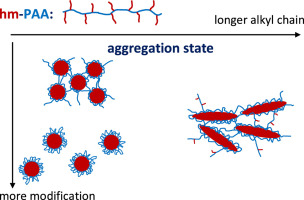Polymer ( IF 4.1 ) Pub Date : 2017-09-04 , DOI: 10.1016/j.polymer.2017.09.005 Sven Riemer , Sylvain Prévost , Michaela Dzionara , Urs Gasser , Michael Gradzielski

|
Hydrophobically modified polyacrylates (hmPAAs) obtained by Atomic Transfer Radical Copolymerisation (ATRP) of mixtures of different alkyl acrylates and t-butyl acrylate and subsequent hydrolysis of the t-butyl acrylate to polyacrylic acid (PAA), were studied with respect to their aggregation behaviour in aqueous solution. The hydrophobic modifications were long alkyl chains that were varied systematically from dodecyl to stearyl, thereby expecting a strong propensity for hydrophobic aggregation. Their structure in aqueous solution was investigated comprehensively by small-angle neutron scattering (SANS) and complemented by dynamic light scattering (DLS) experiments. In these random copolymers the degree of amphiphilicity and hydrophobicity was varied by the percentage of alkyl chains and pH. Due to the length of the alkyl chain all these copolymers have a tendency for microphase separation, but this tendency and the structure of the formed hydrophobic domains depend in a systematic fashion on the precise molecular composition. The domain size scales with the length of the hydrophobic alkyl modification and, for chains of C16 and longer, there is apparently a tendency for elongation. Another interesting observation is that for 20 mol% hydrophobic modification rather self-contained and isolated hydrophobic micellar domains are formed. In contrast, the copolymers with 10 mol% alkyl modification contain interconnected hydrophobic domains as evidenced from the low-q scattering seen in SANS and confirmed by DLS observations. This tendency is further enhanced when fully charging the copolymers. In summary, the molecular design of such random amphiphilic copolymers allows in a nice way to control the aggregation state in solution.
中文翻译:

具有长烷基链的疏水改性聚丙烯酸酯(hmPAAs)–在水溶液中自组装
疏水改性的聚丙烯酸酯由不同的丙烯酸烷基酯的混合物的原子转移自由基共聚合(ATRP)中得到(hmPAAs)和吨-丁基丙烯酸酯的随后的水解吨研究了丙烯酸丁酯到聚丙烯酸(PAA)在水溶液中的聚集行为。疏水改性是长的烷基链,从十二烷基到硬脂基系统地变化,从而期望疏水聚集的强烈倾向。通过小角度中子散射(SANS)全面研究了它们在水溶液中的结构,并通过动态光散射(DLS)实验进行了补充。在这些无规共聚物中,两亲性和疏水性的程度随烷基链的百分数和pH而变化。由于烷基链的长度,所有这些共聚物都具有微相分离的趋势,但是这种趋势和所形成的疏水域的结构以系统的方式取决于精确的分子组成。16和更长的时间,显然存在伸长的趋势。另一个有趣的观察结果是,对于20摩尔%的疏水改性,形成了自包含和分离的疏水胶束结构域。相比之下,具有10 mol%烷基改性的共聚物包含互连的疏水域,这从SANS中观察到的低q散射得到了证明,并通过DLS观察得到了证实。当将共聚物完全装满时,这种趋势进一步增强。总之,这种无规两亲共聚物的分子设计使得可以很好地控制溶液中的聚集状态。











































 京公网安备 11010802027423号
京公网安备 11010802027423号